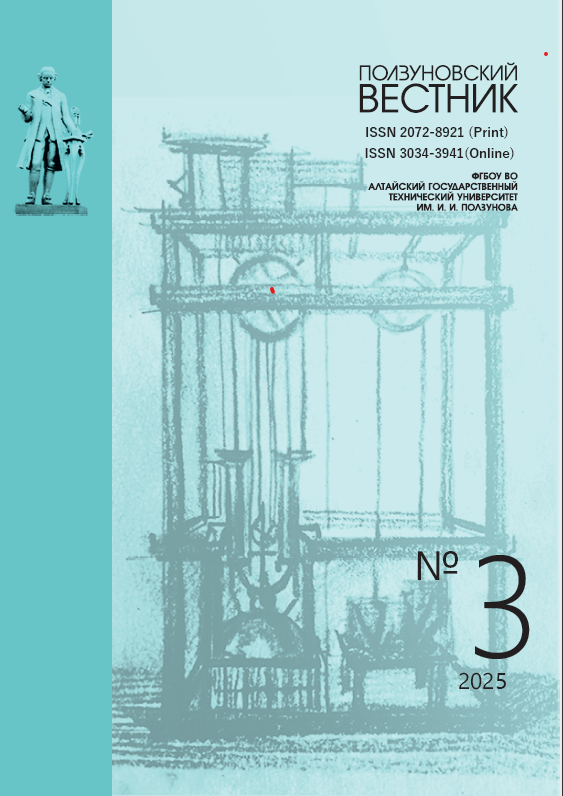HYDROGEN GENERATING MATERIALS BASED ON AMMONIA BORANE AND ETHYLENEDIAMINE BISBORANE: COMPARISON OF HYDROLYSIS REACTION KINETICS
QNBGYR
DOI:
https://doi.org/10.25712/ASTU.2072-8921.2025.03.035Keywords:
ammonia borane, ethylenediamine bisborane, hydrolysis of hydrides, hydrogen production, hydrogen storage, Langmuir-Hinshelwood kinetics, adsorption, activation energy, catalystAbstract
The article presents the results of a comparative study of the kinetics of catalytic hydrolysis of boron-containing hydrides: ammonia borane (AB) and ethylenediamine bisborane (EDBB). The experiments were conducted under identical conditions within a temperature range of 20 to 50 °C. The catalyst used was a copper-cobalt oxide composition (CuO-Co3O4) synthesized through the combustion of a citrate-nitrate precursor. To calculate the kinetic parameters, the Langmuir-Hinshelwood model was applied, which allows taking into account the influence of the hydride adsorption process on the catalyst surface. The results showed that the hydrogen evolution rates during the hydrolysis of AB are higher than those observed for EDBB. However, the calculated activation energy values were found to be comparable: 59.9 ± 0.8 kJ/mol for AB hydrolysis and 55 ± 2 kJ/mol for EDBB hydrolysis. It was found that the higher rate of AB hydrolysis is associated with its more efficient adsorption on the active sites of the catalyst. Specifically, the optimized adsorption constant for AB is 18.5 (mol/L)⁻¹, whereas for EDBB, it is lower at 8 (mol/L)⁻¹, which is likely related to the structural and electronic characteristics of its molecule.
References
Hydrogen storage technologies for stationary and mobile applications: Review, analysis and perspectives / I.A. Hassan [et al.] // Renewable and Sustainable Energy Reviews. 2021. V. 149. P. 111311. DOI: 10.1016/J.RSER.2021.111311.
Нецкина О.В., Комова О.В., Симагина В.И. Изучение генерации водорода из водно-щелочных растворов боргидрида натрия в проточном реакторе // Ползуновский Вестник. 2017. № 4. С. 103–107.
Твердая водородгенерирующая композиция на основе боргидрида натрия: Изучение генерации водорода в воде, взятой из разных источников / О.В. Нецкина [и др.] // Ползуновский Вестник. 2017. № 3. С. 149–153.
Wang С., Astruc D. Recent developments of nanocatalyzed liquid-phase hydrogen generation // Chemical Society Reviews. 2021. V. 50. P. 3437–3484. DOI: 10.1039/d0cs00515k.
Исследование зависимости скорости генерации водорода при гидротермолизе амминборана от размера его частиц / А.М. Горлова [и др.] // Ползуновский Вестник. 2018. № 4. С. 111–115. DOI: 10.25712/ASTU.2072-8921.2018.04.022.
Coşkuner Ö., Kantürk Figen A. Catalytic semi-continuous operation modes for hydrogen generation from carbon derivatives of ammonia boranes // International Journal of Hydrogen Energy. 2022. V. 47. P. 40304–40316. DOI: 10.1016/j.ijhydene.2022.02.
CuO-Co3O4 composite nanoplatelets for hydrolyzing ammonia borane / J. Liao [et al.] // ACS Applied Nano Materials. 2021. V. 4. P. 7640–7649. DOI: 10.1021/acsanm.1c00713.
Rattle-structured CuO/Co3O4@C microspheres, a potent bifunctional catalyst for hydrogen production from ammonia borane hydrolysis and methanolysis / Y. Li [et al.] // Applied Surface Science. 2023. V. 636. P. 157840. DOI: 10.1016/j.apsusc.2023.157840.
Coşkuner Filiz B., Kantürk Figen A., Pişkin S. The remarkable role of metal promoters on the catalytic activity of Co-Cu based nanoparticles for boosting hydrogen evolution: Ammonia borane hydrolysis // Applied Catalysis B: Environmental. 2018. V. 238. P. 365–380. DOI: 10.1016/j.apcatb.2018.07.031.
Coşkuner Filiz B., Kantürk Figen A., Pişkin S. Dual combining transition metal hybrid nanoparticles for ammonia borane hydrolytic dehydrogenation // Applied Catalysis A: General. 2018. V. 550. P. 320–330. DOI: 10.1016/j.apcata.2017.11.022.
Co and Co3O4 in the hydrolysis of boron-containing hydrides: H2O activation on the metal and oxide active centers / V.R. Butenko [et al.] // Materials. 2024. V. 17. P. 1794. DOI: 10.3390/MA17081794.
Andrieux J., Demirci U.B., Miele P. Langmuir-Hinshelwood kinetic model to capture the cobalt nanoparticles-catalyzed hydrolysis of sodium borohydride over a wide temperature range // Catalysis Today. 2011. V. 170. P. 13–19. DOI: 10.1016/j.cattod.2011.01.019.
Retnamma R., Novais A.Q., Rangel C.M. Kinetics of hydrolysis of sodium borohydride for hydrogen production in fuel cell applications: A review // International Journal of Hydrogen Energy. 2011. V. 36. P. 9772–9790. DOI: 10.1016/j.ijhydene.2011.04.223.
Kinetics of Hydrogen Evolution during Ammonia Borane Hydrolysis with Cobalt-Based Catalysts / N.Y. Dyankova [et al.] // Journal of Surface Investigation: X-ray, Synchrotron and Neutron Techniques. 2023. V. 17. P. 1001–1008. DOI: 10.1134/S102745102305004X.
Non-linear kinetic analysis of catalytic hydrolysis of ethylenediamine bisborane with nano-structured Pd/TiO2 catalyst / O.S. Angı [et al.] // International Journal of Hydrogen Energy. 2022. V. 47. P. 40430–40444. DOI: 10.1016/j.ijhydene.2022.04.153.
Cobalt oxide catalyst for hydrolysis of sodium borohydride and ammonia borane / V.I. Simagina [et al.] // Applied Catalysis A: General. 2011. V. 394. P 86–92. DOI: 10.1016/j.apcata.2010.12.028.
Kinetics of sodium borohydride hydrolysis reaction for hydrogen generation / A.J. Hung [et al.] // International Journal of Hydrogen Energy. 2008. V. 33. P. 6205–6215. DOI: 10.1016/j.ijhydene.2008.07.109.
Coşkuner Filiz B, Pişkin S. Investigation on activities of metal oxides catalyzed ammonia borane hydrolysis // Sigma Journal Engineering and Natural Sciences. 2016. V. 34. P. 159–173.
Downloads
Published
How to Cite
Issue
Section
License
Copyright (c) 2025 Anna M. Ozerova, Natalya A. Danilova, Oksana V. Komova, Valentina I. Simagina, Olga V. Netskina

This work is licensed under a Creative Commons Attribution 4.0 International License.















 .
. This work is licensed under a
This work is licensed under a 
